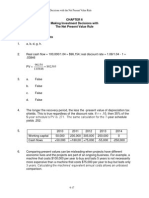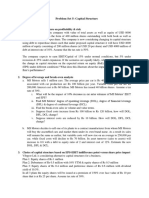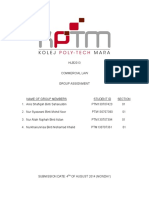Case 03 - The Lazy Mower
Case 03 - The Lazy Mower
Uploaded by
Reda SpongerCopyright:
Available Formats
Case 03 - The Lazy Mower
Case 03 - The Lazy Mower
Uploaded by
Reda SpongerOriginal Title
Copyright
Available Formats
Share this document
Did you find this document useful?
Is this content inappropriate?
Copyright:
Available Formats
Case 03 - The Lazy Mower
Case 03 - The Lazy Mower
Uploaded by
Reda SpongerCopyright:
Available Formats
BUS 306: Corporate Finance I
Case #03
The Lazy Mower: Is It Really Worth It?
If there was one thing the folks at Innovative Products Inc. (IPI) knew well, it was how to come up with useful and unique products in the midst of economic adversity. With current year revenues considerably lower and profit margins shrinking due to severe price competition, the firms engineers had been pushed really hard to develop a prototype of a useful, and hopefully, highly profitable unique product. Then, last month, the design team unveiled a fully-tested prototype of their latest innovation, the remote-controlled lawn mower, nick-named the The Lazy Mower. Surveys of retailers and customers, conducted by the marketing department, indicated that demand would be excellent, provided the price was lower than a riding lawn mower. The testing and developing phases took almost 3 years and the final product passed all safety hazard tests wit flying colors. After the unveiling, the product was exhibited at various home shows nationwide and received raving reviews. Full production had not yet started however, because there had been a change in CEOs and the new CEO was highly conservative. Before being given the go ahead to go into full-scale production of the Lazy Mower, the design team had to present a detailed feasibility study to the Capital Investment Committee (CIC), which was chaired by the Vice President of Finance, Pete Fieldstone. As was typical in a major understanding of this type, the proposal had to include detailed cost and revenue estimates with sufficient documentation to substantiate the numbers. Having been involved with more than a few of these kinds of proposals before, the head of the Design team, Dan Conklin, knew that he had better take every possible factor into consideration and be prepared for a tough and demanding question and answer session at the next committee meeting. Luckily for Dan, his assistant, Ron Howard, who had recently earned his Chartered Financial Analyst (CFA) designation, was an experienced and dependable employee. Prior to being hired by CPC three years ago, Ron had worked for another large engineering company for over 10 years. Ron, we have to dot all the is and cross all the ts on this one! said Dan. Or else, the big guys are going to tear us apart, coz were talking major dollars here. Their main question is going to be, IT IS REALLY WORTH IT? So, Dan and Ron began collecting the necessary information. They knew that to have a comprehensive feasibility study they would have to include the following: 1. Pro-forma statements showing expected annual revenues, variable costs, fixed costs, and net cash flows over the economic life of the project with appropriate supporting documentation. 2. Break-even analysis. 3. Sensitivity of the cash flows to alternative scenarios of sales growth and profit margins. Based on the data provided by the Marketing Department, they prepared Table 1, showing the expected unit sales of the Lazy Mower over its 10-year economic life and the expected selling price per unit. Note that the price of $1000 per unit was estimated to gradually drop to $900 per unit over the 10-year period reflecting competitive pressures. Depreciation for this project was based on the 7-year MACRS rates as shown in Table 2. The cost of equipment, including shipping, handling, and installation, was estimated at $20 million. It was estimated that after 10 years, the equipment and tolls can be soled for $4 million.
BUS 306: Corporate Finance I
Case #03
The manufacturing would be done in an unused plant of the firm. Similar plant locations could be leased for $10,000 per month. Fixed costs were estimated to be $1,500,000 per year while variable production costs per unit were expected to be $400. To get the project under way, additional inventory of $500,000 would be required. The company would increase its accounts payable by $600,000 and its accounts receivable by $1,000,000. Dan and Ron estimated that each year thereafter, the net working capital of the firm would amount to 5% of sales. The weighted average cost of capital was calculated to be 14%. Interest expenses on debt raised to fund the project were estimated to be $400,000 per year. The companys tax rate was expected to remain constant at 34%. Table 1 Innovative Products Inc. Projected Unit Sales and Price for Lazy Mower Unit Sales Unit Price 30,000 $1000 34,000 1000 38,800 1000 38,000 950 36,000 950 36,000 950 35,500 950 35,000 900 34,500 900 34,000 900 Table 2 Modified ACRS Depreciation Allowances 3-Year 5-Year 33.33% 20.00% 44.44 32.00 14.82 19.20 7.41 11.52 11.52 5.76
Year 1 2 3 4 5 6 7 8 9 10
Year 1 2 3 4 5 6 7 8 Questions: Q1. Q2.
7-Year 14.29% 24.49 17.49 12.49 8.93 8.93 8.93 4.45
Prepare a Pro-forma Statement showing the annual cash flows resulting from the Lazy Mower project. Use a scenario analysis to show how the cash flows would change if the sales forecasts were 15% worse (Pessimistic) and 15% better (Optimistic) than the stated forecast (base case). Realizing that the CIC will demand some kind of sensitivity analyses, how should Dan and Ron prepare their report? Which variables or inputs are obvious ones that need to
Q3.
BUS 306: Corporate Finance I
Case #03
be analyzed using multiple values? Explain how the analysis should be performed in that case. Q4. Q5. Q6. How should the annual interest expenses of 400,000 be treated? Explain. Using the base case estimates calculate the cash, accounting and financial break-evens of the Lazy Mower project (each formula will be provided). Interpret each one. Lets say that the company had spent $500,000 in developing the prototype of the Lazy Mower. How should Dave and Rick treat this item in their report? Please explain. Calculate the IRR of the project. recommend? Why? Based on your calculations what would you
Q7. Q8. Q9. Q10.
How sensitive is the Net Present Value of the project to the cost of capital? Construct the NPV profile for the Lazy Mower project. Calculate the degree of operating leverage entailed by this project (appropriate formulas will be provided). What does it indicate? What other types of contingency planning should Dave and Rick include to make the report comprehensive? Please explain the relevance of each suggestion.
You might also like
- The Following Tables Contain Financial Statements For Dynastatics Corporation AlthoughDocument2 pagesThe Following Tables Contain Financial Statements For Dynastatics Corporation Althoughtrilocksp SinghNo ratings yet
- Case 03 - The Lazy Mower - SolutionDocument7 pagesCase 03 - The Lazy Mower - SolutionDũngPham67% (3)
- Case Study: Professor CorwinDocument13 pagesCase Study: Professor CorwinPotukuchi SidhardhaNo ratings yet
- MCQ Paper 1of JAIIBDocument60 pagesMCQ Paper 1of JAIIBpraveena100% (2)
- Practice Problems Capital Structure 25-09-2021Document17 pagesPractice Problems Capital Structure 25-09-2021BHAVYA KANDPAL 13BCE02060% (1)
- If The Coat FitsDocument4 pagesIf The Coat FitsAngelica Olesco100% (1)
- Puyallup Mall CaseDocument5 pagesPuyallup Mall Casecarlosev110% (1)
- Practical Financial Management Appendix BDocument16 pagesPractical Financial Management Appendix Bitumeleng10% (1)
- Analysing Risk and Return On Chargers Products' Investments: Case Analysis in BA 142Document7 pagesAnalysing Risk and Return On Chargers Products' Investments: Case Analysis in BA 142ice1025No ratings yet
- Shapiro CHAPTER 6 SolutionsDocument10 pagesShapiro CHAPTER 6 SolutionsjzdoogNo ratings yet
- Precision Tool CompanYDocument6 pagesPrecision Tool CompanYMelissa Rosemond100% (1)
- Total Tower Case 1Document6 pagesTotal Tower Case 1Maya BoraNo ratings yet
- Case 11Document10 pagesCase 11Trương Quốc VũNo ratings yet
- Tutorial 5 Chapter 4&5Document3 pagesTutorial 5 Chapter 4&5Renee WongNo ratings yet
- Description of Knoll:: Knoll Furniture: Going PublicDocument3 pagesDescription of Knoll:: Knoll Furniture: Going PublicIni EjideleNo ratings yet
- Pricing Ppt. Principles of MarketingDocument17 pagesPricing Ppt. Principles of MarketingGendyBoco100% (1)
- Shapiro CHAPTER 3 Altered SolutionsDocument17 pagesShapiro CHAPTER 3 Altered Solutionsjimmy_chou1314100% (1)
- Chapter 13 MK 2Document5 pagesChapter 13 MK 2Novelda100% (1)
- Chapter 14 Exercise SolutionsDocument16 pagesChapter 14 Exercise SolutionsCarol Robinson100% (1)
- Chicago Valve TemplateDocument5 pagesChicago Valve TemplatelittlemissjaceyNo ratings yet
- Shapiro CHAPTER 2 SolutionsDocument14 pagesShapiro CHAPTER 2 SolutionsPradeep HemachandranNo ratings yet
- 17 Answers To All ProblemsDocument25 pages17 Answers To All ProblemsRaşitÖnerNo ratings yet
- Chap 009Document19 pagesChap 009Neetu RajaramanNo ratings yet
- Exam 1 Quantitative Methods For Management (SM 60.65)Document7 pagesExam 1 Quantitative Methods For Management (SM 60.65)zeeshansheikh70% (2)
- Real Options and Capital Budgeting (I Wish I Had A Crystal Ball)Document4 pagesReal Options and Capital Budgeting (I Wish I Had A Crystal Ball)Ian S. DaosNo ratings yet
- Case StdyDocument3 pagesCase StdyNora OsmanNo ratings yet
- RMontoya SolutaDocument21 pagesRMontoya SolutaTy Best CoonNo ratings yet
- Case Study No. 3 PDFDocument6 pagesCase Study No. 3 PDFMuhammadZahirGulNo ratings yet
- Lesson Five HomeworkDocument3 pagesLesson Five HomeworkLiam100% (1)
- Zong BDocument3 pagesZong BAbdul Rehman AmiwalaNo ratings yet
- Chapter 6Document26 pagesChapter 6dshilkarNo ratings yet
- Chapter 02 - Basic Financial StatementsDocument139 pagesChapter 02 - Basic Financial StatementsElio Baz100% (1)
- 11 LasherIM Ch11Document26 pages11 LasherIM Ch11Goran Gothai80% (5)
- International Associates Ia Is About To Commence Operations AsDocument1 pageInternational Associates Ia Is About To Commence Operations AsAmit PandeyNo ratings yet
- CH 11Document51 pagesCH 11Nguyen Ngoc Minh Chau (K15 HL)No ratings yet
- Case Case:: Colorscope, Colorscope, Inc. IncDocument4 pagesCase Case:: Colorscope, Colorscope, Inc. IncBalvinder SinghNo ratings yet
- ManCon - Green Valley (Final Draft)Document13 pagesManCon - Green Valley (Final Draft)Jerome Luna Tarranza100% (1)
- Solved Write in Algebraic Form A Calculation of U K Pounds PerDocument1 pageSolved Write in Algebraic Form A Calculation of U K Pounds PerM Bilal SaleemNo ratings yet
- Chapter 18. CH 18-06 Build A ModelDocument4 pagesChapter 18. CH 18-06 Build A ModelNguyễn Thu PhươngNo ratings yet
- CH 04 - SolutionsDocument17 pagesCH 04 - SolutionsLuong Hoang Vu100% (2)
- 15 LasherIM Ch15Document14 pages15 LasherIM Ch15advaniamrita67% (3)
- Exercises For The Hybrid MBA Corporate Finance CourseDocument28 pagesExercises For The Hybrid MBA Corporate Finance Coursealex_bucNo ratings yet
- Management Accounting - 2: Project Report By-Group - A4Document11 pagesManagement Accounting - 2: Project Report By-Group - A4ANSHIKA SINGHNo ratings yet
- f5 Class Test 1Document5 pagesf5 Class Test 1Emon D' CostaNo ratings yet
- Financial Leverage and Capital Structure Policy: Conducted by Ranjika Perera & Chanaka KarunasenaDocument53 pagesFinancial Leverage and Capital Structure Policy: Conducted by Ranjika Perera & Chanaka Karunasenacharitha007No ratings yet
- CASE 8 - Norman Corporation (A) (Final)Document3 pagesCASE 8 - Norman Corporation (A) (Final)Katrizia FauniNo ratings yet
- Practice Question PST CTADocument4 pagesPractice Question PST CTAKeith P. KatsandeNo ratings yet
- Ch13 P11 Build A Model 1Document24 pagesCh13 P11 Build A Model 1walabuNo ratings yet
- Look at Qu P9-15Document10 pagesLook at Qu P9-15Sara Voysey100% (1)
- Solutions Manual: Introducing Corporate Finance 2eDocument30 pagesSolutions Manual: Introducing Corporate Finance 2eJeremiah100% (1)
- Latif Khan, Architect Income Statement For The Period Ended March 31, 2012Document4 pagesLatif Khan, Architect Income Statement For The Period Ended March 31, 2012Harshdeep BhatiaNo ratings yet
- CH 03 - SolutionsDocument17 pagesCH 03 - SolutionsLuong Hoang Vu80% (5)
- Problem Set 5: Capital StructureDocument3 pagesProblem Set 5: Capital StructureGautam PatilNo ratings yet
- Fin-450 CH 13 QUIZDocument7 pagesFin-450 CH 13 QUIZNick Rydal JensenNo ratings yet
- Chapter 6 Exercise AnswersDocument6 pagesChapter 6 Exercise AnswersLuong Hoang Vu100% (1)
- Problem 13-1 - Chapter 13 - SolutionDocument6 pagesProblem 13-1 - Chapter 13 - Solutionppdisme100% (1)
- The PharaohDocument6 pagesThe PharaohSymeraNo ratings yet
- CH 12Document3 pagesCH 12ghsoub777No ratings yet
- Chapter 6 Answer Key (1 15)Document15 pagesChapter 6 Answer Key (1 15)Desrifta FaheraNo ratings yet
- Account Case StudyDocument9 pagesAccount Case Studyamado_florezNo ratings yet
- Group 3 Benchmarking-1Document15 pagesGroup 3 Benchmarking-1Primrose ChisungaNo ratings yet
- Shell Brand C I GuideDocument40 pagesShell Brand C I GuideRolando Daclan100% (1)
- 6 Mixed-Integer Linear Programming PDFDocument18 pages6 Mixed-Integer Linear Programming PDFAugusto De La Cruz CamayoNo ratings yet
- Csa NVQ Assessor CVDocument2 pagesCsa NVQ Assessor CVMike KelleyNo ratings yet
- Balakrishnan MGRL Solutions Ch12Document30 pagesBalakrishnan MGRL Solutions Ch12iluvumiNo ratings yet
- Kanthal 2Document3 pagesKanthal 2Ramesh MandavaNo ratings yet
- 25 Proven Option Strat Cme-113 - 21brochure - Side - SRDocument32 pages25 Proven Option Strat Cme-113 - 21brochure - Side - SRAashir AgrawalNo ratings yet
- Fauji Fertilizer Company LimitedDocument12 pagesFauji Fertilizer Company LimitedAasi RaoNo ratings yet
- MKT624 - Final Term Quiz Master File SolvedDocument69 pagesMKT624 - Final Term Quiz Master File SolvedAzeem AhmadNo ratings yet
- Resa P2 Final April 2008Document15 pagesResa P2 Final April 2008Arianne Llorente100% (1)
- Blake Galmarini ResumeDocument2 pagesBlake Galmarini Resumeapi-307765522No ratings yet
- Assignment - Commercial LawDocument15 pagesAssignment - Commercial LawNURKHAIRUNNISANo ratings yet
- Simple Marketing System: CommunicationDocument26 pagesSimple Marketing System: CommunicationAshish LallNo ratings yet
- Company Analysis-DELL INC: History and BackgroundDocument4 pagesCompany Analysis-DELL INC: History and BackgroundBivor DhakalNo ratings yet
- Transfer PricingDocument111 pagesTransfer PricingMamun0% (1)
- Oddanchatram Visit PDFDocument4 pagesOddanchatram Visit PDFArun PrasathNo ratings yet
- Filinvest Vs Golden HavenDocument3 pagesFilinvest Vs Golden HavenAnonymous 5rMjvwNo ratings yet
- MergedDocument4 pagesMergedThinesshvaranKanniappanNo ratings yet
- Stop Talking and Start Listening PDFDocument4 pagesStop Talking and Start Listening PDFelisaNo ratings yet
- Question PapersDocument6 pagesQuestion PaperskhanheenakhanNo ratings yet
- Commercial Item Determinations SpendLogic PDFDocument4 pagesCommercial Item Determinations SpendLogic PDFwa duNo ratings yet
- Best Efforts PDFDocument8 pagesBest Efforts PDFRahmaReyhanNo ratings yet
- Case Study QANTASDocument12 pagesCase Study QANTASAlexanderWebbNo ratings yet
- HOBA QuestionsDocument7 pagesHOBA QuestionsKristine CorporalNo ratings yet
- Bilal Departmental StoreDocument13 pagesBilal Departmental StoreShanNo ratings yet
- Sbi MarketingDocument6 pagesSbi MarketingJoshi RaghuNo ratings yet
- Real Estate Agent Resume SampleDocument2 pagesReal Estate Agent Resume Sampleresume7.com100% (3)
- Cfa Studies - Foreign Exchange ArithmeticDocument4 pagesCfa Studies - Foreign Exchange ArithmeticIshteyaqNo ratings yet
- Newsvendor ProblemDocument24 pagesNewsvendor ProblemNestor Diaz LunaNo ratings yet

























































































